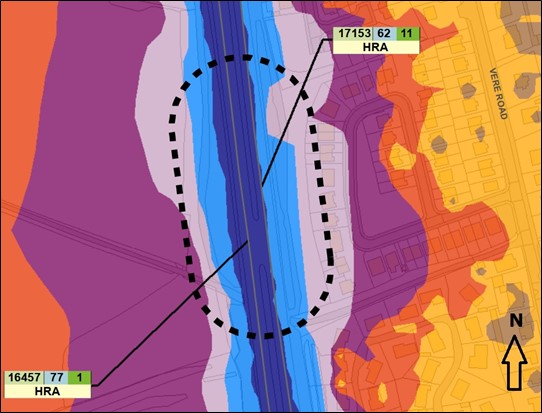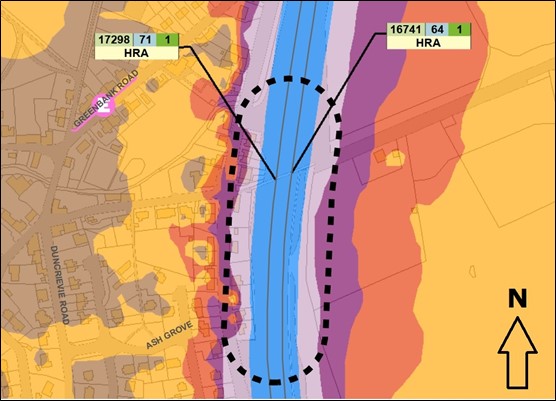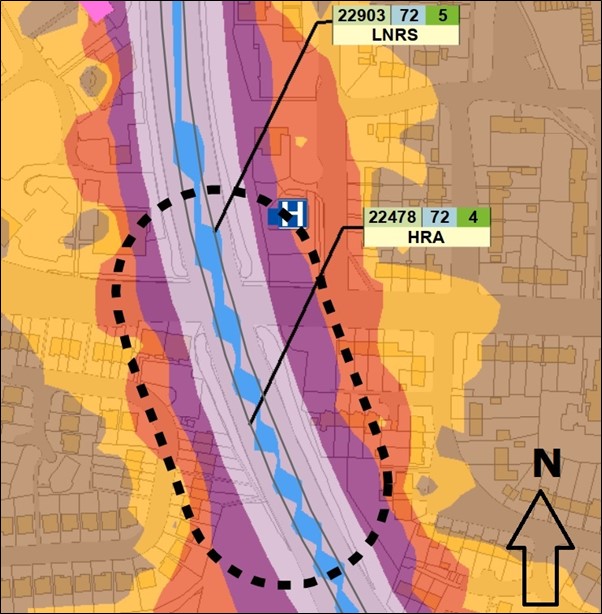5 - Cost Benefit of TS2010 - Examples
5.1. Introduction
This Section discusses cost benefit assessments and provides three indicative case study examples of Candidate Noise Management Areas (CNMAs) where TS2010 could be considered. The cost benefit assessment is undertaken over a 60-year period, in line with guidance given in The Green Book.
5.1.1. Benefits
The benefit of a noise reduction is based on assessing the resulting improvements in health impacts i.e. a reduction in noise exposure can result in a decrease in negative health impacts and improvement in quality of life for the average population. Health impacts include: annoyance; sleep deprivation; blood pressure effects, and more. The WebTAG online guidance from the Department for Transport provides a risk-based approach to assessing impacts of noise and monetises the change in health impacts per household.
5.1.2. Costs
The cost of TS2010 per metre squared is taken as £19/m2, based on PPR443 Table 11.2 (Published Project Report PPR443 “A review of current research on road surface noise reduction techniques”, Transport Research Laboratory, P G Abbott, P A Morgan and B McKell, January 2010. ). This is indicative only and cost information does not include: indirect costs, planing of the original road surface, or tack coats.
The cost of resurfacing with HRA or similar surface is taken to be approximately the same as TS2010. Therefore, the cost of the mitigation is currently assumed to be zero for a road that is due to be resurfacing anyway. If more detailed 60-year cost information can be provided, then more detailed cost benefit ratio examples can be provided.
An in-depth cost benefit assessment was undertaken by Atkins Limited on behalf of Defra (NANR201), with the main objective of the project being to provide practical advice for assessing the costs and benefits of noise control measures, primarily for road traffic and railway noise sources. There are multiple case studies provided, and regarding the cost benefit of Low Noise Surface the following is said at paragraph 8.83:
“…since roads need to be re-surfaced as part of routine maintenance, the cost of the measure is the difference between the cost of maintaining the existing road surface compared with the cost of maintaining the new road surface. Table 7.6 identifies that a Thin Wearing Course has a shorter design life [10 years] than a Hot Rolled Asphalt surface [15 years], and therefore resurfacing would be required more frequently. The economic cost of this would be approximately equal to the cost of the initial cost, including planing the existing road surface.”
Based on discussions between Atkins and Transport Scotland, TS2010 is assumed to have an approximate 15-year life span in comparison to 12-year life span for HRA. Therefore, over the 60-year assessment period this would give TS2010 a cost advantage as one less resurfacing application is required. However, a more detailed 60-year cost assessment should be undertaken to verify this.
5.1.3. Assessment
The Benefit Cost Ratio (BCR) is the ratio between the benefits (present value benefits) and the costs (present value costs) of a mitigation measure.
Simple 3D computer noise models have been generated for each of the case studies. These models have:
- simplified topography with open source 10m ground contours used in the noise model;
- road traffic details taken from CNMA noise maps;
- road surface assumed to be HRA with 2mm texture depth (0 dBA at ≥75kmph and -1 dBA at ≤75kmph);
- residential buildings set to height of 6 metres.
The road surface noise corrections for TS2010 (10mm) are assumed to be as follows:
- -3 dBA – for roads with speeds of ≥75kmph*
- -1 dBA – for roads with speeds of ≤75kmph
*This correction is subject to confirmation following further studies to establish the RSI for TS2010.
The findings of these indicative cost benefit assessment are provided below.
5.2. Example 1 – M74 (CNMA 2) - Kirkmuirhill
CNMA 2 is located adjacent to the M74 in Kirkmuirhill in South Lanarkshire. There are approximately 12 properties in the CNMA adjacent to the southbound carriageway. The traffic data and surface information has been taken from the noise map provided (see below). A 600m section of road (both carriageways) were treated in the noise model, totalling approximately 8,400m2.

Due to the speeds provided, only the northbound carriageway would receive a noise reduction due to use of TS2010, therefore the overall noise reduction at the residential properties is approximately -1.2dB(A). This results in a total net present value benefit of £22,109.
For demonstration purposes, if the southbound speed is adjusted to 75kmph then TS2010 provides a reduction on both carriageways and the overall noise reduction at the residential properties is approximately -3dB(A). This results in a total net present value benefit of £99,626.
It is likely that the overall noise reduction and hence net present value would be somewhere between these two scenarios discussed above.
Only the 12 properties in the CNMA have been included in the benefit calculation (1st floor windows only). If the calculations are extended to the surrounding properties, then this would further increase the net present benefit values calculated above. The more densely populated the CNMA and the more properties near the area being treated, the higher the monetised benefit from the mitigation measure.
The total present value cost of applying TS2010 rather than HRA is not known but, as discussed above, it could be cost neutral. However, even if there is an overall negative cost impact of adopting TS2010, provided the cost does not exceed the reported benefit, the benefit cost ratio would be >1, and hence adopting TS2010 would be considered cost beneficial based on the noise benefits alone.
5.3. Example 2 – M90 (CNMA 90) - Glenfarg
CNMA 90 is located adjacent to M90 in Glenfarg, Perthshire. There are approximately 12 properties in the CNMA adjacent to the northbound carriageway. The traffic data and surface information has been taken from the noise map provided (see below). A 600m section of road (both carriageways) were treated in the noise model, totalling approximately 8,400m2.

The speeds provided on the above noise map are both below 75kmph, therefore, based on the current approach, and in accordance with current CRTN and DMRB methodology, there would not be any noise benefit to resurfacing using TS2010 over a new HRA surface, or similar.
However, it is known that low noise surfaces, and likely TS2010, do provide noise reductions at speeds below 75kmph. Therefore, as with CNMA2 above, if an assumption is made that average speeds on both carriageways are around 75kmph and noise reduction benefits of up to -3dB(A) are realised at the 12 properties in the CNMA, then this results in a total net present value benefit of up to approximately £99,626.
Only the 12 properties in the CNMA have been included in the benefit calculation (1st floor windows only). If the calculations are extended to the surrounding properties, then this would further increase the net present benefit value calculated above.
5.4 Example 3 – A92 (CNMA 112) – Glenrothes
CNMA 112 is located adjacent to A92 in Glenrothes, Perthshire. There are approximately 20 properties in the CNMA adjacent to both the northbound and southbound carriageways. The traffic data and surface information has been taken from the noise map provided (see below). A 600m section of road (both carriageways) were treated in the noise model, totalling approximately 8,400m2.

The speeds provided on the above noise map are both just below 75kmph, therefore, based on the current approach, and in accordance with current CRTN and DMRB methodology, there would not be any noise benefit to resurfacing using TS2010 over a new Low Noise Road Surface (LNRS) or HRA surface, or similar.
However, in terms of roadside noise emission there is negligible difference between a mean speed of 72 and 75kmph (approximately 0.1dBA). Therefore, the above speeds have been adjusted to 75kmph to provide another example scenario. It is assumed that the LNRS on the southbound carriageway would be replaced with a like for like new surface i.e. achieving the full -3.5dB(A) noise reduction.
By adopting TS2010 and applying the -3dB(A) correction, noise reduction benefits of between -0.9dB(A) and -2.0dB(A) are calculated at the 20 properties in the CNMA. The larger reductions in noise are adjacent to the northbound carriageway where TS2010 is used in place of HRA, this is where most of the properties are located. In this scenario, where speeds of 75kmph are assumed, the total net present value benefit of up to approximately £106,154.
Based on replacing the LNRS every 10 years, HRA every 12 and assuming every 15 years for TS2010, there may not be a cost impact of adopting TS2010 over a 60-year period. However, this is subject to a more detailed review of 60-year costs.
It should be noted that where all lanes on both carriageways are LNRS i.e. -3.5dB(A) correction, TS2010 would offer no noise reduction benefit, although, as stated above there may be a positive costs differential to be considered.
5.5. Other Considerations
It should be noted that re-surfacing using TS2010 is expected to provide a noise reduction benefit where the existing road surface is particularly noisy (concrete, paving blocks, etc..) and/or in particularly poor condition. At low speeds (typically 30mph zones) this noise benefit is likely to be comparable to that which would be achieved using an HRA or SMA surface. See the tests undertaken in Gardziejczyk et al. (“Noisiness of the Surfaces on Low-Speed Roads”. Authors: Wladyslaw Gardziejczyk, Pawel Gierasimiuk and Marek Motylewicz, Division of Road Engineering, Faculty of Civil and Environmental Engineering, Bialystok University of Technology. © 2016 by the authors; licensee MDPI, Basel, Switzerland. This article is an open access article distributed under the terms and conditions of the Creative Commons by Attribution (CC-BY) license (http://creativecommons.org/licenses/by/4.0/).). The prominence of engine noise at low speeds would limit the overall noise reductions achievable and specific noise test data for TS2010 on low speed roads would be required to develop this further. Next Steps
5.6. Recommendations
It is recommended that noise measurements are undertaken of the TS2010 road surface using the Statistical Pass-By method stipulated in BS EN ISO 11819:2001. Two sites will be selected where a high-speed road has been surfaced with TS2010 and is approximately 12-18 months old.
This approach would provide controls for the traffic flow, speed of measured vehicles, and meteorological conditions and road surface conditions. The benefits of using the Statistical Pass-By method are that an RSI and acoustic correction, bespoke to TS2010, can be calculated and the results from the testing can be more readily compared with other products. The RSI values can be used in to derive surface correction in accordance with the methodology of DMRB HD213/11.
Atkins Ltd has skilled acousticians and former TRL staff with experience of planning and undertaking such SPB measurements and assessments.
If adopted this assessment would need to measure separately the 10mm and 8mm versions of TS2010. It is likely that 14mm TS2010 will offer limited noise benefit, if any, above other SMA and HRA surfaces, however, measurements could also be taken for this version of the surface if requested.
The current programme of CRTN style measurements would provide some indication of the performance of the surfaces over time. However, more accurate, robust data would be obtained by undertaking the SPB measurements after say 1, 2, 3, 5 and 10 years.
5.6.1. DMRB and CRTN Revisions
It is worth noting that at the time of writing, DMRB HD213/11 is being re-written and CRTN is under review. It is not known what changes, if any, may be made to either document regarding the way road surface noise corrections are calculated and/or applied on UK road scheme assessments. No significant changes are anticipated regarding the use of SPB measurements for determining RSI and deriving surface corrections, however, it may be prudent to wait for the outcomes of these revised documents.